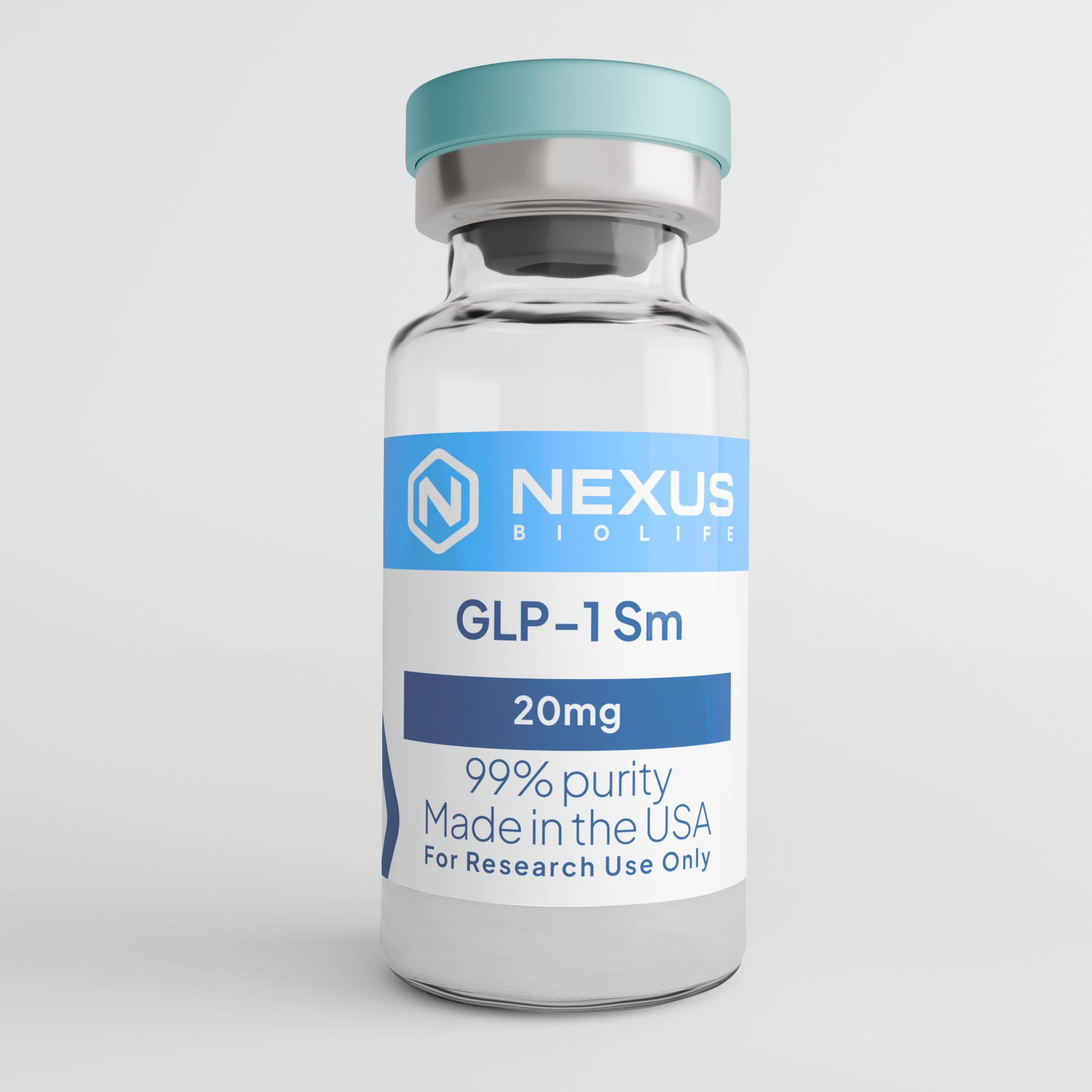
GLP-1 Sm is a synthetic peptide meticulously prepared for scientific inquiry. This product is synthesized with high purity. It is utilized in various laboratory investigations. GLP-1 Sm is designated solely for research and development purposes.

GLP-1 Sm's structure is derived from GLP-1(7-37), with key modifications including substitution of alanine at position 8 with 2-aminoisobutyric acid (Aib) to resist dipeptidyl peptidase-4 (DPP-4) cleavage, and acylation at lysine 26 with a C18 fatty diacid attached via a γ-glutamic acid spacer and two 8-amino-3,6-dioxaoctanoic acid (OEG) units. This results in a molecular formula of C187H291N45O59 and an approximate molecular weight of 4113.58 g/mol, facilitating strong albumin binding (>99%) and a prolonged half-life of about one week in experimental models. These alterations maintain a helical conformation essential for receptor interaction while reducing renal clearance and enhancing bioavailability in assays.
In practical terms, GLP-1 Sm is typically provided as a lyophilized powder with purity levels exceeding 98%, verified by HPLC and mass spectrometry. It demonstrates good solubility in neutral aqueous buffers, though the fatty acid moiety may require gentle handling to prevent aggregation. Our commitment to transparency includes thorough testing for consistency, ensuring it's ready for your in-vitro work without unexpected variables.
GLP-1 Sm is a long-acting glucagon-like peptide-1 (GLP-1) receptor agonist with 94% structural homology to native human GLP-1, engineered to enhance stability and duration for exploring metabolic and endocrine pathways in research models. This 31-amino-acid peptide features modifications that promote albumin binding and resistance to enzymatic degradation, making it an excellent tool for in-vitro studies on glucose homeostasis, appetite regulation, and energy metabolism. Remember, our GLP-1 Sm is supplied strictly for research purposes and in-vitro use only—not for human consumption or any diagnostic or therapeutic applications.
GLP-1 Sm primarily binds to GLP-1 receptors, stimulating glucose-dependent insulin secretion from pancreatic beta cells through cAMP-mediated pathways like PKA/PI3K/mTOR and PI3K/AKT, while inhibiting glucagon release from alpha cells to curb hepatic gluconeogenesis. It enhances insulin sensitivity by promoting GLUT4 translocation in skeletal muscle and adipose tissue via AMPK/SIRT1 signaling, and supports beta-cell proliferation while reducing apoptosis through CREB and FOXO1 regulation. In appetite control, it activates POMC/CART neurons and inhibits NPY/AgRP pathways in the hypothalamus, interacting with leptin to boost satiety and energy expenditure.
Additionally, GLP-1 Sm promotes adipose tissue browning by upregulating UCP1, PGC-1α, and other thermogenic markers via AMPK/SIRT1, enhancing mitochondrial biogenesis and fatty acid oxidation. Its anti-inflammatory effects involve NF-κB inhibition, reducing cytokines like TNF-α and IL-6, and it mitigates oxidative stress through SIRT1/NRF2 activation, quenching ROS and supporting autophagy. These interconnected pathways—centered on AMPK/SIRT1/PGC-1α—offer a comprehensive view of how GLP-1 Sm modulates metabolic balance in cellular models. We're always ready to discuss these details further, helping you design experiments that highlight specific aspects.
In summary, GLP-1 Sm serves as a robust GLP-1 analog for delving into intricate metabolic networks, from insulin dynamics to anti-inflammatory responses, thanks to its optimized structure and multifaceted signaling pathways. Its potential in research models inspires our dedication to providing high-quality peptides that advance scientific understanding with integrity. Exclusively for in-vitro use, GLP-1 Sm highlights our passion for education and collaboration in peptide science. Let's work together to unlock new insights, one carefully crafted experiment at a time.
GLP-1 Sm's versatile profile supports a wide array of in-vitro and ex-vivo research, particularly in metabolic disorders, inflammation, and tissue remodeling. In cell culture models, such as adipocytes or hepatocytes, it has been used to investigate browning of white adipose tissue, showing upregulation of thermogenic genes and improved mitochondrial function. Preclinical studies in db/db mice have demonstrated its anti-hyperglycemic effects and body weight reduction, providing insights into insulin sensitivity and beta-cell function. In atherosclerosis models like ApoE-/- mice, GLP-1 Sm probes anti-inflammatory pathways, reducing plaque formation and vascular remodeling.
Researchers also apply it in neuronal cell lines to explore appetite regulation, examining hypothalamic signaling and leptin interactions for obesity studies. In cardiac cell assays, it has shown cardioprotective potential by reducing apoptosis and oxidative stress, useful for modeling diabetic cardiomyopathy. Its long-acting nature makes it ideal for time-course experiments assessing sustained receptor activation. We encourage exploring these applications with our educational resources, like assay optimization guides, to ensure precise and reproducible outcomes in your lab.
To maintain GLP-1 Sm's stability for your research, store the lyophilized powder at -20°C or below in a dry, dark environment, protecting it from moisture and light to preserve the fatty acid linkage. For reconstitution, use sterile bacteriostatic water or a neutral pH buffer to achieve concentrations of 1-5 mg/mL, gently swirling to dissolve without foaming, as vigorous mixing could disrupt the structure. Once prepared, aliquot solutions and store at 2-8°C for short-term use (up to a week) or freeze at -20°C, avoiding repeated freeze-thaw cycles to prevent degradation.
Always verify solution clarity and pH before assays—aim for neutral conditions to optimize receptor-binding efficacy. Our quality controls include stability assessments, but if you encounter issues, our team offers logical troubleshooting based on evidence-based practices.
GLP-1 Sm is a long-acting glucagon-like peptide-1 (GLP-1) receptor agonist with 94% structural homology to native human GLP-1, engineered to enhance stability and duration for exploring metabolic and endocrine pathways in research models. This 31-amino-acid peptide features modifications that promote albumin binding and resistance to enzymatic degradation, making it an excellent tool for in-vitro studies on glucose homeostasis, appetite regulation, and energy metabolism. Remember, our GLP-1 Sm is supplied strictly for research purposes and in-vitro use only—not for human consumption or any diagnostic or therapeutic applications.
GLP-1 Sm primarily binds to GLP-1 receptors, stimulating glucose-dependent insulin secretion from pancreatic beta cells through cAMP-mediated pathways like PKA/PI3K/mTOR and PI3K/AKT, while inhibiting glucagon release from alpha cells to curb hepatic gluconeogenesis. It enhances insulin sensitivity by promoting GLUT4 translocation in skeletal muscle and adipose tissue via AMPK/SIRT1 signaling, and supports beta-cell proliferation while reducing apoptosis through CREB and FOXO1 regulation. In appetite control, it activates POMC/CART neurons and inhibits NPY/AgRP pathways in the hypothalamus, interacting with leptin to boost satiety and energy expenditure.
Additionally, GLP-1 Sm promotes adipose tissue browning by upregulating UCP1, PGC-1α, and other thermogenic markers via AMPK/SIRT1, enhancing mitochondrial biogenesis and fatty acid oxidation. Its anti-inflammatory effects involve NF-κB inhibition, reducing cytokines like TNF-α and IL-6, and it mitigates oxidative stress through SIRT1/NRF2 activation, quenching ROS and supporting autophagy. These interconnected pathways—centered on AMPK/SIRT1/PGC-1α—offer a comprehensive view of how GLP-1 Sm modulates metabolic balance in cellular models. We're always ready to discuss these details further, helping you design experiments that highlight specific aspects.
In summary, GLP-1 Sm serves as a robust GLP-1 analog for delving into intricate metabolic networks, from insulin dynamics to anti-inflammatory responses, thanks to its optimized structure and multifaceted signaling pathways. Its potential in research models inspires our dedication to providing high-quality peptides that advance scientific understanding with integrity. Exclusively for in-vitro use, GLP-1 Sm highlights our passion for education and collaboration in peptide science. Let's work together to unlock new insights, one carefully crafted experiment at a time.
GLP-1 Sm's structure is derived from GLP-1(7-37), with key modifications including substitution of alanine at position 8 with 2-aminoisobutyric acid (Aib) to resist dipeptidyl peptidase-4 (DPP-4) cleavage, and acylation at lysine 26 with a C18 fatty diacid attached via a γ-glutamic acid spacer and two 8-amino-3,6-dioxaoctanoic acid (OEG) units. This results in a molecular formula of C187H291N45O59 and an approximate molecular weight of 4113.58 g/mol, facilitating strong albumin binding (>99%) and a prolonged half-life of about one week in experimental models. These alterations maintain a helical conformation essential for receptor interaction while reducing renal clearance and enhancing bioavailability in assays.
In practical terms, GLP-1 Sm is typically provided as a lyophilized powder with purity levels exceeding 98%, verified by HPLC and mass spectrometry. It demonstrates good solubility in neutral aqueous buffers, though the fatty acid moiety may require gentle handling to prevent aggregation. Our commitment to transparency includes thorough testing for consistency, ensuring it's ready for your in-vitro work without unexpected variables.

GLP-1 Sm's versatile profile supports a wide array of in-vitro and ex-vivo research, particularly in metabolic disorders, inflammation, and tissue remodeling. In cell culture models, such as adipocytes or hepatocytes, it has been used to investigate browning of white adipose tissue, showing upregulation of thermogenic genes and improved mitochondrial function. Preclinical studies in db/db mice have demonstrated its anti-hyperglycemic effects and body weight reduction, providing insights into insulin sensitivity and beta-cell function. In atherosclerosis models like ApoE-/- mice, GLP-1 Sm probes anti-inflammatory pathways, reducing plaque formation and vascular remodeling.
Researchers also apply it in neuronal cell lines to explore appetite regulation, examining hypothalamic signaling and leptin interactions for obesity studies. In cardiac cell assays, it has shown cardioprotective potential by reducing apoptosis and oxidative stress, useful for modeling diabetic cardiomyopathy. Its long-acting nature makes it ideal for time-course experiments assessing sustained receptor activation. We encourage exploring these applications with our educational resources, like assay optimization guides, to ensure precise and reproducible outcomes in your lab.
To maintain GLP-1 Sm's stability for your research, store the lyophilized powder at -20°C or below in a dry, dark environment, protecting it from moisture and light to preserve the fatty acid linkage. For reconstitution, use sterile bacteriostatic water or a neutral pH buffer to achieve concentrations of 1-5 mg/mL, gently swirling to dissolve without foaming, as vigorous mixing could disrupt the structure. Once prepared, aliquot solutions and store at 2-8°C for short-term use (up to a week) or freeze at -20°C, avoiding repeated freeze-thaw cycles to prevent degradation.
Always verify solution clarity and pH before assays—aim for neutral conditions to optimize receptor-binding efficacy. Our quality controls include stability assessments, but if you encounter issues, our team offers logical troubleshooting based on evidence-based practices.
